David Muirhead recently witnessed some unusual behaviour by a pair of Moonlighter, Tilodon sexfasciatus at Moonta Bay jetty (11th March 2022).

He later posted four photos that he managed to take of the pair during his snorkel in the jetty swimming enclosure on iNaturalist.

David reported his sighting thus:
“Initially I assumed that the 2 adult moonlighters were having some sort of territorial dispute, although I have not seen the species do so before. On the contrary they seem to be reasonably sociable amongst each other and are known to school occasionally.
“It soon became apparent that this was a courtship display, which involved repeatedly rapidly circling each other when very close to each other, interspersed with brief rests. But the clincher for me was to see them facing each other, motionless in mid water, with their mouths touching. Like a kiss.
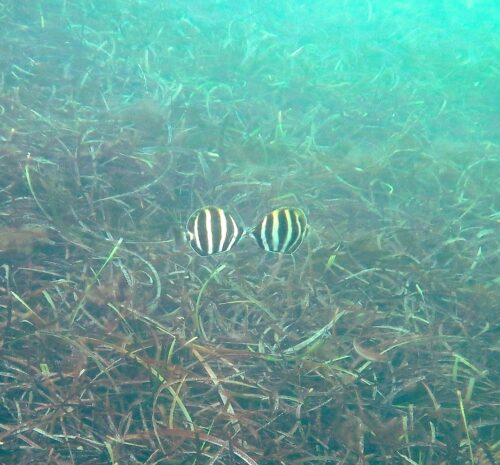
“I don’t have a better explanation for this behaviour, anyway. And it occurred at low tide in the shadiest section of the swimming enclosure (beneath the jetty itself which is very wide to accommodate people topside who watch the swimmers and in some cases supervise children learning to swim).”
David sought my opinion (or interest). My immediate thought was recalling seeing Kissing Gouramis in aquariums several decades ago. I did an online search to find out just why Kissing Gouramis kiss.
According to Petigloo, “The Kissing fish kisses as an aggressive response to conspecifics or physically similar species. This aggression occurs due to territory, female and resource disputes.”
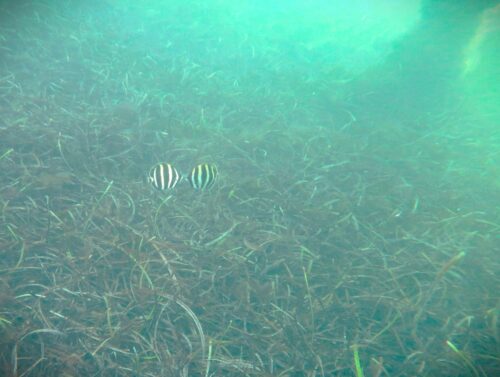
Further, “Kissing fish is scientifically known as Helostoma temminkii and can also be popularly called Kissing gourami. They are freshwater fish originally from Asian tropical slow-moving waters, such as ponds, lakes and swamps. They occupy water in Thailand, Indonesia, Malaysia, Vietnam, Borneo and Cambodia. In the wild, they usually live around aquatic vegetation.
“They have a white-pinkish colouration, which can vary between silver-greenish to reddish. However it is not found in the wild, the white-pinkish colour is the most common for pet tanks. There are also shape varieties that have been selected artificially, such as the Balloon Pink Kissing fish, also called Dwarf Kissing fish. This variety is not very strong and has a shorter lifespan.
“They can breathe atmospheric oxygen. They own an accessory organ called labyrinth that makes this process possible. They are normally around 15 centimetres. However, some may reach up to 30 centimetres. Though, it is important to have some fish raising experience and plenty of space to raise one.
“Why do Kissing fish kiss? – Kissing fish are semi-aggressive fish. They can become very territorial when in the presence of conspecifics or other physically similar species. When they are kissing other fish, it is not an affectionate sign. It is actually a fight. This behaviour of locking and protruding lips and pushing each other is typical of Kissing fish aggressions.
“Consequently, by having thick lips, additional joints and frontal teeth, when they start a fight it looks like they are kissing. That is where the “Kissing” name comes from. This fight is associated with pushing competition, for hierarchy and dominance. It just ends when one of the fighters gives up, or in some extreme cases when the fish breaks their jaws.
“For this reason, it is recommended that Kissing fish should be kept separately from fish of the same species. And also, if kept with other species, you should consider having similar or larger sizes to avoid Kissing fish kisses. If you follow the size recommendation, you should have a nice peaceful community in your tank.
“In addition to the kissing fight, it is also possible to detect some kisses when Kissing fish are eating. This is because they have an additional joint in their jaws, which allows them to protrude their mouth while eating to scratch organisms from rocks and other rigid structures. For this reason, the kissing behaviour becomes even more evident.”
My thought from all of this is that the two Moonlighters were actually fighting, NOT courting.
When I told David Muirhead of my findings, he responded “Thanks Steve, I think you’re probably right, especially in autumn when you would not expect courtship activity. But we’re both guessing 🙃.”
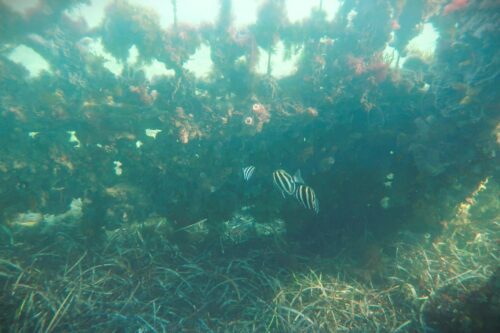
In a classic case of good timing, before I received David’s response, I found some video footage posted to Facebook by Tim Rogers showing two large Blue Devils at Rapid Bay behaving similarly to the Moonlighters.
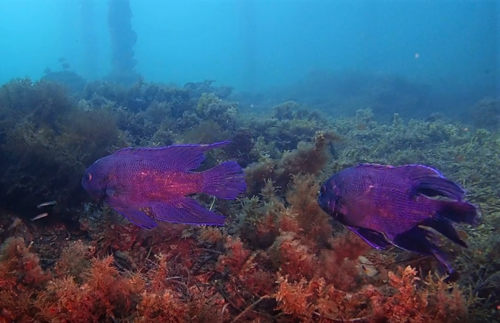
Tim suggested that the two Blue Devils may have been performing a courting dance. He added that they both apparently swapped partners shortly after the video was taken. It turned out, however, that he was told that “one of the “pair” moved over to another Blue Devil about 20m away and started performing the “dance ” with them”.
The initial footage can be seen at https://www.facebook.com/tim.rogers.182/videos/688843325636946 .

At this stage, I’m sticking with “aggressive behaviour” in Autumn, rather than “courting behaviour”. I believe that cuttlefish also become aggressive during autumn.
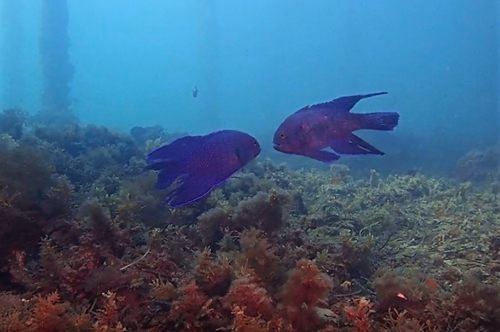
(My thanks got to David Muirhead and Tim Rogers for their photos, video footage and information in relation to this topic.)
Header photo and all Blue Devil photos taken by Tim Rogers. Moonlighter photos all taken by David Muirhead.


[…] is all possibly another example of Fish Behaviour Observed During Autumn […]